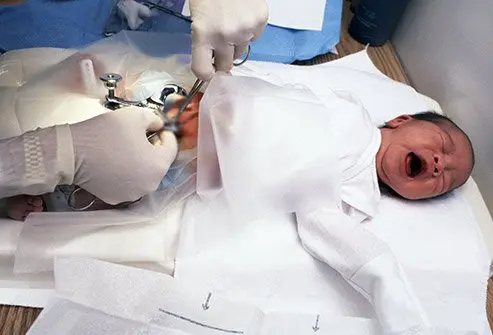Male child circumcision, the surgical removal of the foreskin, has been a topic of discussion for generations. In this article, we’ll delve into the five common methods for circumcising a baby boy and provide insights to help parents make informed decisions. From anaesthesia to specialized tools and techniques, we’ll cover it all. So, let’s get started!
Now, let’s dive into each of these methods and procedures to understand the best way to circumcise a baby.
1. Anesthesia Method
The anaesthesia method ensures that the procedure is as painless as possible for the baby. Various techniques include penile ring block, penile dorsal nerve block, local anaesthetic spray, and jet injector.
Penile Dorsal Nerve Block – A Closer Look
The penile dorsal nerve block is a secure and effective anaesthesia procedure for circumcision. It involves administering a local anaesthetic agent around two key positions of the penis, the trunk of the dorsal nerve and its ventral branch. However, it must be done carefully, ensuring the injection is below the symphysis pubis deep to the fascia. Avoiding the midline is crucial to prevent hematoma or an inefficient nerve block.
2. Shield and Clamp Method
This method involves using a metal shield to protect the glans while the excess prepuce is removed. The frenulum, a sensitive area, is usually not included in the excision.
3. Plastibell Method
The Plastibell method utilizes a plastic bell with a groove on its back. A dorsal slit is made in the prepuce, and the prepuce is pulled forward. The suture material is looped around the groove and tied, cutting off the blood supply to the prepuce, causing it to fall off within a week or more.
Understanding Glans Necrosis
Preventing glans necrosis and selecting the right bell size are essential factors for the success of this method. A loose bell size can lead to unnecessary bleeding.
4. The Gomco Method
The Gomco method employs a metal bell placed over the glans, followed by a dorsal slit to remove the prepuce.
5. Shang Ring Method
The Shang Ring method involves a device with both an inner and outer ring. After local anaesthesia, the inner ring is placed below the glans, allowing the foreskin to roll back. The outer ring is secured, and the excess skin is removed.
Hemostatic Stitches
Some male circumcision methods carry the risk of bleeding. Therefore, the application of hemostatic stitches is necessary to prevent bleeding.
Benefits and Risks of Male Child Circumcision
Before deciding on the best method for your child, it’s important to weigh the benefits and risks associated with male-child circumcision. Circumcision may reduce the risk of certain infections and simplify personal hygiene, but it’s not without potential complications.
FAQs (Frequently Asked Questions)
- Is circumcision safe for newborns?
- Yes, when performed by a skilled healthcare professional, circumcision is generally safe for newborns. Complications are rare but can occur.
- What are the potential complications of circumcision?
- Complications may include bleeding, infection, or improper healing. However, these are rare and can be managed with medical attention.
- Is circumcision a personal choice or a cultural/religious tradition?
- Circumcision can be both a personal choice and a cultural or religious tradition. It is important for parents to make an informed decision that aligns with their beliefs and values.
- At what age should male child circumcision be performed?
- Male child circumcision is most commonly performed during the neonatal period, typically within the first few days after birth.
- Can circumcision be performed later in life if it’s not done as a baby?
- Yes, circumcision can be performed at any age, but the procedure may be more complex and may require more extensive aftercare in older children and adults.
In conclusion, male child circumcision is a medical procedure with various methods, each having its unique features and considerations. The choice of method should be made with careful deliberation and consultation with a healthcare professional. The goal is to ensure the child’s health and well-being while respecting cultural and personal beliefs.
Now that we’ve explored the best ways to circumcise a baby and addressed common questions, you can make an informed decision about this important aspect of your child’s health.
